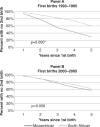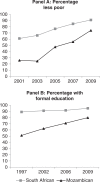Convergence in fertility of South Africans and Mozambicans in rural South Africa, 1993-2009
- PMID: 23364078
- PMCID: PMC3556705
- DOI: 10.3402/gha.v6i0.19236
Convergence in fertility of South Africans and Mozambicans in rural South Africa, 1993-2009
Abstract
Background: Although there are significant numbers of people displaced by war in Africa, very little is known about long-term changes in the fertility of refugees. Refugees of the Mozambican civil war (1977-1992) settled in many neighbouring countries, including South Africa. A large number of Mozambican refugees settled within the Agincourt sub-district, underpinned by a Health and Socio-demographic Surveillance Site (AHDSS), established in 1992, and have remained there. The AHDSS data provide a unique opportunity to study changes in fertility over time and the role that the fertility of self-settled refugee populations plays in the overall fertility level of the host community, a highly relevant factor in many areas of sub-Saharan Africa.
Objectives: To examine the change in fertility of former Mozambican self-settled refugees over a period of 16 years and to compare the overall fertility and fertility patterns of Mozambicans to host South Africans.
Methods: Prospective data from the AHDSS on births from 1993 to 2009 were used to compare fertility trends and patterns and to examine socio-economic factors that may be associated with fertility change.
Results: There has been a sharp decline in fertility in the Mozambican population and convergence in fertility patterns of Mozambican and local South African women. The convergence of fertility patterns coincides with a convergence in other socio-economic factors.
Conclusion: The fertility of Mozambicans has decreased significantly and Mozambicans are adopting the childbearing patterns of South African women. The decline in Mozambican fertility has occurred alongside socio-economic gains. There remains, however, high unemployment and endemic poverty in the area and fertility is not likely to decrease further without increased delivery of family planning to adolescents and increased education and job opportunities for women.
Keywords: Agincourt health and socio-demographic surveillance site; adaptation; adolescent fertility; birth intervals; contraception; education; fertility decline; labour force participation; refugees; socio-economic development.
Figures




Similar articles
-
Childhood mortality among former Mozambican refugees and their hosts in rural South Africa.Int J Epidemiol. 2004 Dec;33(6):1271-8. doi: 10.1093/ije/dyh257. Epub 2004 Aug 19. Int J Epidemiol. 2004. PMID: 15319405
-
Mozambican refugee resettlement: survival strategies of involuntary migrants in South Africa.J Refug Stud. 1994;7(2-3):220-38. doi: 10.1093/jrs/7.2-3.220. J Refug Stud. 1994. PMID: 12346890
-
Social patterns and differentials in the fertility transition in the context of HIV/AIDS: evidence from population surveillance, rural South Africa, 1993 - 2013.Popul Health Metr. 2016 Mar 25;14:10. doi: 10.1186/s12963-016-0079-z. eCollection 2016. Popul Health Metr. 2016. PMID: 27019642 Free PMC article.
-
Adolescent childbearing in developing countries: a global review.Stud Fam Plann. 1998 Jun;29(2):117-36. Stud Fam Plann. 1998. PMID: 9664627 Review.
-
Fertility and family planning in southern and central Africa.Stud Fam Plann. 1992 May-Jun;23(3):145-58. Stud Fam Plann. 1992. PMID: 1523695 Review.
Cited by
-
Let's Talk about Sex, Maybe: Interviewers, Respondents, and Sexual Behavior Reporting in Rural South Africa.Field methods. 2016;28(2):112-132. doi: 10.1177/1525822X15595343. Epub 2015 Aug 13. Field methods. 2016. PMID: 28190977 Free PMC article.
-
Modelling fertility in rural South Africa with combined nonlinear parametric and semi-parametric methods.Emerg Themes Epidemiol. 2018 Mar 2;15:5. doi: 10.1186/s12982-018-0073-y. eCollection 2018. Emerg Themes Epidemiol. 2018. PMID: 29507596 Free PMC article.
-
Relationship between school dropout and teen pregnancy among rural South African young women.Int J Epidemiol. 2015 Jun;44(3):928-36. doi: 10.1093/ije/dyv007. Epub 2015 Feb 24. Int J Epidemiol. 2015. PMID: 25716986 Free PMC article.
-
Fieldworker effects on substance use reporting in a rural South African setting.Int J Alcohol Drug Res. 2018;7(1):29-39. doi: 10.7895/ijadr.246. Int J Alcohol Drug Res. 2018. PMID: 31191791 Free PMC article.
-
A bivariate Poisson regression to analyse impact of outlier women on correlation between female schooling and fertility in Malawi.BMC Womens Health. 2024 Jan 20;24(1):55. doi: 10.1186/s12905-024-02891-w. BMC Womens Health. 2024. PMID: 38245736 Free PMC article.
References
-
- United Nations High Commissioner for Refugees. Refugee Figures. 2012. Available from: http://www.unhcr.org/pages/49c3646c1d.html [cited 19 July 2012]. - PubMed
-
- White MJ, Tagoe E, Stiff C, Adazu K, Smith DJ. Urbanization and the fertility transition in Ghana. Popul Res Policy Rev. 2005;24:59–83.
-
- Lindstrom DP. Rural-Urban migration and reproductive behavior in Guatemala. Popul Res Policy Rev. 2003;22:351–72.
-
- Lee BS, Pol LG. The influence of rural-urban migration on migrants’ fertility in Korea, Mexico and Cameroon. Popul Res Policy Rev. 1993;12:3–26.
-
- McGinn T. Reproductive health of war-affected populations: what do we know? Int Fam Plan Perspect. 1993;26:174–80.
Publication types
MeSH terms
Grants and funding
LinkOut - more resources
Full Text Sources
Other Literature Sources
